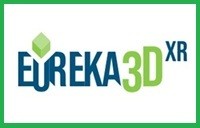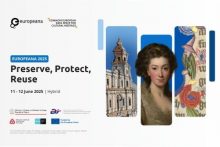This article, first published in the Winter 2014 edition of Animated magazine, is reproduced by permission of Foundation for Community Dance. All Rights Reserved. See www.communitydance.org.uk/animated for more information.
Professor of Dance and Director of the Centre for Dance Research (C-DaRE) at Coventry University (RICHES’ Partner) Sarah Whatley argues for a change in perceptions for every body dancing.
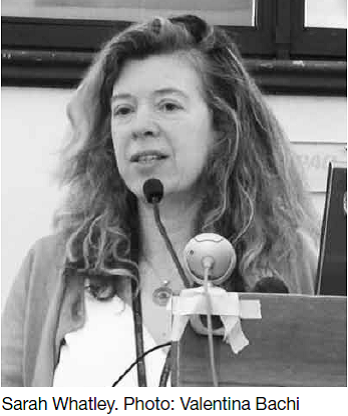 Perhaps the greatest barrier for dancers with disabilities accessing dance at a Higher Educational (HE) level is the perception that a career in dance is ‘off limits’ to them. A student may feel that the course will not prepare them with the skills, knowledge and independence to take them into work beyond graduation. But every aspiring dance student is different. Each has their own sense of ability and identity, and sometimes multiple identities (which may include them as a member of the disabled community). But it is probably the case that whilst the student with a disability has had to come to terms with a sense of being more different her entire life, and the realities of the barriers that get in the way of her being able to ignore her difference, the prejudices that still lurk in the dance studio and are re-inscribed in the ‘perfected’ dancing bodies in the name of ‘excellence’ and ‘quality’ persist through an aesthetic of similarity and flawlessness. And that does no favour to any dancer, disabled or non-disabled, and neither does it move the artform forwards.
Perhaps the greatest barrier for dancers with disabilities accessing dance at a Higher Educational (HE) level is the perception that a career in dance is ‘off limits’ to them. A student may feel that the course will not prepare them with the skills, knowledge and independence to take them into work beyond graduation. But every aspiring dance student is different. Each has their own sense of ability and identity, and sometimes multiple identities (which may include them as a member of the disabled community). But it is probably the case that whilst the student with a disability has had to come to terms with a sense of being more different her entire life, and the realities of the barriers that get in the way of her being able to ignore her difference, the prejudices that still lurk in the dance studio and are re-inscribed in the ‘perfected’ dancing bodies in the name of ‘excellence’ and ‘quality’ persist through an aesthetic of similarity and flawlessness. And that does no favour to any dancer, disabled or non-disabled, and neither does it move the artform forwards.
There are of course examples of individuals with disabilities, who have carved out interesting and productive careers as dancers and in the dance sector more generally, but these individuals are too few and many have had to find a way into the profession that has bypassed full-time HE or vocational dance training. So whose responsibility is it to ensure that dancers with disabilities are included?
Many dance curricula do not overtly discriminate against the dancer with disabilities. But that doesn’t mean to say that the curriculum is accessible, appropriate and inviting to those students who may perceive themselves to be discriminated against. Some are more explicit in addressing inclusion; for example the relationship between Trinity Laban and Candoco, now just over a year in operation, has, according to the website, been set up ‘to achieve greater access for disabled people into the dance profession and to advocate for the importance of inclusive practice in enhancing creative endeavour’. Such statements are to be welcomed but where (else) is change happening? Most dance courses place unusually high demands on students when compared to other subject domains. Students work long hours, working collaboratively with others, developing a wide range of intelligences, all of which can feel daunting to navigate for students with physical, sensory or cognitive disabilities. Students are unlikely to find themselves in classes where there are others with visible disabilities, so whilst there may be an ethos of inclusion within the class, the experience of the student who feels her difference to be hypervisible may be that she finds the dance class (in particular) an uncongenial environment in which to feel equal but different.
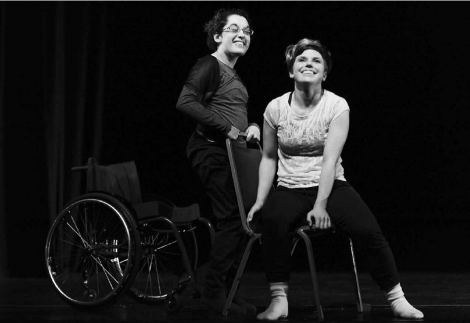
Anna Bergstrom and Kimberley Harvey, Subtle Kraft Co., Cravings of Intimacy & Solitude, Theatre Clywdd, Wales. Photo: Roswitha Chesher
The uncomfortable truth is that there is also still anxiety and fear amongst many who design and teach courses in dance in HE about how to accommodate and support students with disabilities. This is not surprising given the additional work needed. No student, disabled or not, simply slips into an existing provision without some kind of adaptation or additional support, if only for monitoring how the various strands of a course and its related assessment take account of, or not, the individual’s needs.
So what will make a difference? We have to change perceptions and this begins much earlier than the time when students might access HE. We also have to invite disabled students to audition and apply for our courses and then learn with them about how we might need to shift or rethink our curricula. Hopefully each student will be a valuable ambassador to encourage others to follow but this carries with it a weight of responsibility, which not all students will want.
Equally if not more important, we have to appoint role models in our institutions; as dance course leaders, studio teachers, managers, lecturers and researchers. Then the discourse of ‘inclusion’ will evolve to reflect an inclusive community of practice in our universities and colleges, and beyond into the profession, which focuses on the materiality of every dancing body and which will then, in turn, undermine those structures that still persist in reinforcing systems of oppression and exclusion in dance.
For more information: http://www.communitydance.org.uk/animated-magazine.html
Read the full article, with the contributions of Benjamin Dunks (benjamin@attik.org.uk), Artistic Director of Plymouth’s Attik Dance, and Kimberley Harvey (kimberleyharvey1@aol.com, www.subtlekraftco.tumblr.com), freelance dancer, teacher and choreographer – PDF
contact s.whatley@coventry.ac.uk
visit www.c-dare.co.uk
www.invisibledifference.org.uk




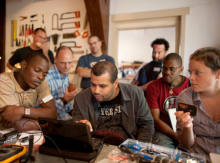


 If you have interesting news and events to point out in the field of digital cultural heritage, we are waiting for your contribution.
If you have interesting news and events to point out in the field of digital cultural heritage, we are waiting for your contribution.








